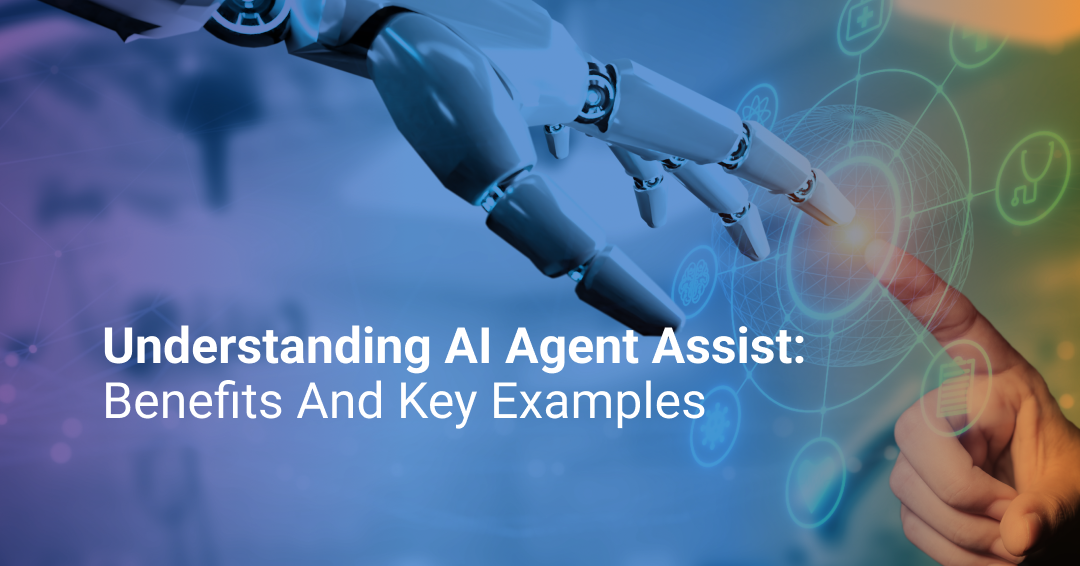What's AI Agent Assist? Benefits and Examples
Modern businesses, especially large-scale enterprises, face the key challenge of overburdening their customer support teams while looking to scale...
7 min read
![]() Mosaicx
:
October 30, 2024
Mosaicx
:
October 30, 2024

The advent of artificial intelligence (AI) has completely reshaped the traditional call center model. Relying on outdated systems, especially when on the frontlines of customer service, carries a great risk of inconsistent service quality, inefficient customer handling, and struggling to keep up with increasing customer demands and expectations. AI addresses all those challenges, transforming a legacy call center into an intelligent, modernized business.
With automated call handling and real-time insights to enhance both human agents and customer experience, AI-driven call centers are another step into the digital future. Acting now means improving operational efficiency and gaining a competitive advantage in customer service.
AI can transform call centers into an efficient and customer-friendly business that can handle large volumes of complex interactions while maintaining a high quality of service. Here are a few ways AI is reshaping call centers in the modern-day digital market.
These three technologies form the cornerstones of a modern-day AI-driven call center.
NLP (Natural Language Processing) allows AI to understand and handle customer queries, providing personalized interactions and assisting human agents by providing real-time suggestions or insights.
ML (Machine Learning) similarly helps automate routine processes but also improves operational efficiency by predicting customer behaviors and reactions through a bulk analysis of past interactions and trends. This allows a call center to optimize its services to recommend the best possible solution to a customer.
NLU (Natural Language Understanding) helps AI find context in customer interactions to simulate human-like responses. This includes detecting emotions and sentiments while assisting human agents respond with more accuracy.
AI can understand customer needs by automatically routing their calls to the most appropriate department or agent. This reduces wait times and increases the chances of first-call resolutions. Such intelligence routing also helps organize information for call centers to streamline their workflow.
AI can detect emotions from a customer’s voice, adjusting the tone of the conversation based on customer frustration or satisfaction. Such real-time responses based on sentiments improve interaction outcomes for call centers.
The biggest way AI is modernizing call centers for human agents is by balancing their workload. AI virtual assistants can handle routine or repetitive tasks, allowing human agents to handle tasks that require critical thinking, especially during peak hours.
In addition, human agents can use AI-powered tools to guide them through customer interactions. This can be in the form of real-time prompts to de-escalate frustrated customers or handle sensitive situations.
AI has significantly changed how supervisors and sales leaders operate in a call center. They now get real-time insights for various metrics to make data-driven decisions to improve operational efficiency. For example, supervisors can access dashboards to monitor agent productivity, call resolutions, customer satisfaction, etc. This also includes predictive analytics for proactive customer service.
Leveraging AI-powered tools and solutions is a strategic move for call centers to not only improve their efficiency but also to stay competitive in the current volatile global markets.
Unlike human operators, using AI in a call center can provide customer support with instant responses around the clock. This reduces wait times and improves customer experience significantly. Continually learning from customer interactions using machine-learning algorithms means that AI can offer quick and more accurate solutions, contributing to better customer satisfaction for customer retention and loyalty.
Deploying IVAs in call centers to automate routine inquiries helps reduce costs in several ways. The need for a large team of human agents is minimized because AI can simultaneously handle multiple calls in bulk. There is also no need for an off-the-clock team because conversational AI assistants can provide support 24/7, and generate automated call summaries to update human agents the next day.
With AI learning (and evolving) to improve its ability to address customer needs with instant responses, call centers can optimize their workforce allocation, cut down on training expenses, and streamline their operations for improved efficiency while maintaining a high level of service.
Call centers are renowned for their high attrition rate. Shifting the workload of human agents by having conversational AI handle their mundane or repetitive tasks reduces burnout and stress, two critical factors leading to high attrition in call centers. Employee satisfaction and morale improve, leading to a healthy work environment with increased efficiency.
AI-powered call center software offers a data-driven approach, where customer data from past interactions can be analyzed for critical insights. Intelligent virtual agents (IVAs) can also pull customer information in real time to personalize responses and solutions. This leads to targeted recommendations and offers that customers are likely to appreciate, resulting in satisfied customers.
One of the biggest advantages of using AI in call centers is its easy scalability in handling large volumes. This can be during peak seasonal times or unexpected surges. Having a flexible solution that can scale without additional costs or delays gives an edge over competitors.
AI scaling also helps expand operations outwards to enter new markets. With add-on tools such as automated translations and 24/7 availability, call centers can achieve an omnichannel presence to meet their customer requirements anywhere without compromising on quality.
Every advantage of using AI in call centers combines to address pain points and offer a good return on investment. Owners get to reduce overheads and operational expenses, improve customer experience and sales with data-driven solutions, and free human agents to focus on complex issues; all the while having the option to scale at will.
Successfully implementing an AI solution allows call centers to maximize the benefits of AI. Here are some important implementation practices to consider.
Similar to any other business, every call center does not necessarily have to have the same needs. Yours might have a different set of challenges you want to resolve with AI. Hence, call center owners should identify areas of improvement and only then choose an AI solution that best fits their requirements. This ensures that the AI will directly address pain points.
The cost of implementation is also an important factor to consider. Some call centers might not have the budget to go directly for the best AI solution in the market. Other factors to consider include security features, scalability options, ease of integration, etc.
Implementing training and development in call centers covers both the AI and the employees. Firstly, the AI is only as good as its ability to learn and adapt. Certain metrics must be in place to monitor how well the AI performs or whether its recommended solutions could have been better. Secondly, human agents must be trained to utilize AI tools to improve efficiency. For example, there is little point in using AI to gather high-quality customer data if the sales leaders cannot convert that data into meaningful leads.
The first step in identifying the best performance metrics for call centers is to define their business goals. These should be realistic and relevant to what call centers want to achieve based on historical data or industry benchmarks.
For example, improving the customer satisfaction rating through surveys, the average call handling time and the duration of calls made, the percentage of issues resolved on the first call, etc.
Monitoring every metric is an opportunity to improve, and for call centers to refine their strategy or workflow accordingly.
Customers expect personalization in every interaction. Delivering that earns their loyalty. Use AI to handle basic inquiries, and move the human agents to provide personalized and empathetic support.
Maintain a balance between artificial intelligence and human interactions, so a call can quickly shift to a live agent if the customer has a complex issue or wants a human agent. Such a customer-centric strategy gives call centers a better chance of leaving their customers satisfied.
Integration of AI technology with legacy call center systems is crucial for success. Hire only professionals to ensure all operations are running smoothly and effectively to avoid service disruptions or faulty results. It is also equally important to perform quality tests and monitor the AI performance to intervene if the AI starts showing non-compliant behavior.
Another best practice for call center owners is a phased approach toward AI implementation. Set milestones to give the team enough time to adapt while identifying areas for improvement. Make adjustments over time before scaling up. This reduces the risk of overwhelming staffers with new technologies and ensures smoother integration while minimizing disruptions.
A common misconception is that artificial intelligence can completely replace human agents to run a fully automated call center. That might be something to consider in the future, but as of now, AI is not meant to replace call center employees.
Rather AI is meant to assist and enhance live agents and supervisors by automating their routine tasks and giving them data and tools to work smarter.
Note that customers can often demand human interaction even if conversational AI can simulate human-like speech. That human touch, critical thinking, and personalized solutions is something AI cannot replace.
Several AI-powered trends are on the rise in 2025 and changing how call centers do business. In the future, AI technologies are expected to become more advanced, featuring seamless integration to enhance customer experience and operational efficiency tenfold.
Predictive Analytical Foresights: With AI evolving, predictive analytics is expected to become even more advanced, offering solutions in advance for customers not even aware of the oncoming problem. Customers' needs will be anticipated before they reach out, opening a new door in tailored and personalized campaigns.
Real-Time Language Translations: A digitally connected globe means call centers will eventually face language constraints when entering new markets. AI will make this possible by providing real-time language translations to break language barriers.
Data Privacy: Another technological trend expected to become a norm for call centers is the role of AI ethics in data privacy. Stricter regulations will roll out to keep AI algorithms in check, and call centers will have to find ways to protect their sensitive customer data. Metrics like loyalty and trust will mean trusting in a brand’s ability to provide privacy.
Emotional Intelligence Detection: Conversational AI is evolving to accurately detect emotional changes in speech. The customer’s voice and choice of words, the way they break their sentences, and several other speech patterns. In the near future, call center AI systems will easily be able to respond according to the emotional changes in the conversation or alert a live agent when needed.
IVAs and IVRs are used in call centers to enhance customer support, but their automated features differ significantly. IVAs are the way of the future, particularly in user experience.
The comparison clearly highlights why call centers must switch from the old IVR to the new IVA technologies. For starters, IVAs offer quick resolutions, lower call durations, and reduce customer frustrations due to their advanced, natural interactions. Call centers with IVAs also get to cut down on expenses by automating routine tasks. Finally, unlike IVRs, IVAs can be easily scaled to learn and grow, which means more cost savings on labor and time.
Mosaicx offers comprehensive AI-driven systems that capture, organize, and analyze information for call centers to help them improve operations.
Shifting from legacy IVR to our robust Mosaicx Engage gives you the power of conversational AI to deliver contextual human-like responses while being ready to adapt the conversation flow based on customers’ sentiments, emotions, or tone.
It works alongside intelligent call routing to assist human agents with complex customer interactions, reduce wait times, and reduce the time to resolve for improved customer satisfaction.
In addition, Mosaicx Outreach shares critical data insights to anticipate your customers' needs with predictive messaging and help you find the best solutions for customers. With automated reporting and predictive analytics, sales leaders are always primed to make informed decisions and drive growth with proactive campaigns.
Start leveraging the power of AI to change your customer support experience today. Get started by scheduling a demo to see first-hand how our conversational AI platform handles large volumes of calls, collects data, and measures effectiveness at every stage.

Modern businesses, especially large-scale enterprises, face the key challenge of overburdening their customer support teams while looking to scale...

Customer expectations are changing drastically. What once gave an edge is now simply expected. Hence, it should not be surprising to see businesses...

With customer service expectations at an all-time high, businesses are turning to automation to deliver great support, save costs, and streamline...